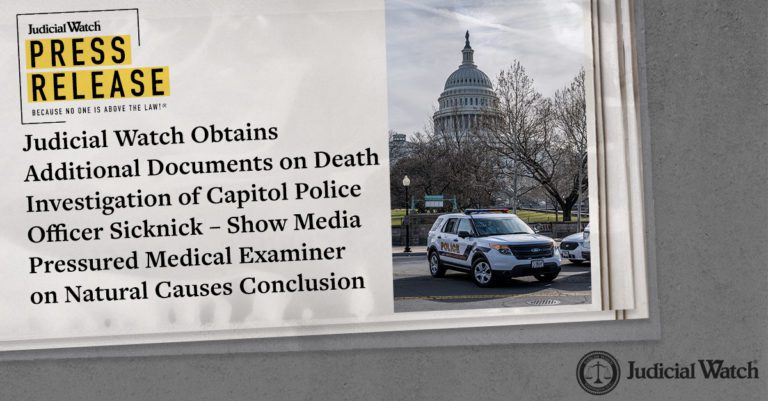
Judicial Watch Obtains Additional Documents on Death Investigation of Capitol Police Officer Sicknick – Show Media Pressured Medical Examiner on Natural Causes Conclusion

(Washington, DC) – Judicial Watch announced today that it received an additional 2,440 pages of records related to the death of U.S. Capitol Police Officer Brian Sicknick which show major media representatives pressuring the Office of the Chief Medical Examiner (OCME) of the District of Columbia over its conclusion that Officer Sicknick had died of natural causes.
On April 20, one day after Officer Sicknick’s autopsy results were released, CNN reporter Jen Christensen emailed the medical examiner’s office, asking “how someone could die of natural causes after a traumatic event.”
In an April 20 email to the medical examiner’s office, reporter Sarah Mimms of BuzzFeed News presses for “clarity” on the death determination: “I’m really pressing on clarity here not only because of the importance of this case but also because USCP and the Justice Department initially said that Officer Sicknick died due to injuries he sustained at the Capitol. [Emphasis in original] We want to be accurate, which may mean updating those original stories about how he died, if the ME [medical examiner] can clarify this key point.”
Judicial Watch obtained the documents in a Freedom of Information Act (FOIA) lawsuit filed after the medical examiner’s office denied a February 16, 2021, FOIA request (Judicial Watch v. District of Columbia (No. 2021 CA 000875 B)). Judicial Watch asked for:
All records, including but not limited to autopsy reports, toxicology reports, notes, photographs, and OCME [medical examiner] officials’ electronic communications, related to the death on January 6, 2021 of Capitol Police Officer Brian Sicknick and its related investigation.
Pressure from this lawsuit helped lead to the April disclosure that Capitol Police Officer Brian Sicknick died of natural causes.
On February 7, Dr. Brent Harris, Director of Neuropathology at Georgetown University Hospital, emailed D.C. Medical Examiner Dr. Sasha Breland, saying, “Sasha, here’s the draft for your rush case and a paper I found on the topic. Take a look and let me know your thoughts.” The attached paper was titled, “Basilar artery thrombosis after cervical injury 2010.”
On January 8, medical examiner investigator Leigh Fields Broadbent emailed medical examiner colleagues regarding the Sicknick case, saying, “Accepted: 21-00132> Please contact Special Agent Riley, FBI [redacted] regarding the start time of the autopsy. He will be waiting in his car outside the building by 0730-0800 hrs regardless. DONE – he and the US Attorney will be coming down btwn 0900-0930 hrs. MPD will present btwn 0800-0830hrs.”
Dr. Samantha Tolliver, the Chief Toxicologist for the medical examiner’s office, indicated that a “draft report” had been completed in the Sicknick death investigation on February 17.
A “preliminary toxicology report” on Sicknick was completed by March 2, 2021.
Of the 10 outlets that filed FOIA requests seeking Officer Sicknick’s autopsy report, as of March 25, according to the medical examiner’s office’s talking points, all 10 were denied, but only Judicial Watch appealed the denial.
Following the submission of Judicial Watch’s appeal, DC General Counsel Rodney Adams emailed chief medical examiner Dr. Francisco Diaz, and copying the medical examiner’s special assistant Cheryle Adams and Chief of Staff Beverly Fields, saying: “And the celebration was short lived … A Judicial Watch reporter has immediately appealed my denial of his request for the case file of Off. Brian Sicknick who died during the Jan. 6th riot at the Capitol. We have several other reporters requesting it as well.” [Note: Officer Sicknick died at the hospital on January 7, not “during the January 6 riot at the Capitol.”]
On March 31, medical examiner Francisco Diaz emailed medical examiner official Anna Francis, saying, “Can you please restrict access to E-file in this case,” referring to the Sicknick investigation. Francis replied, “What groups should be eliminated? These are the only groups that have access to the entire decedent file. Files are not in a completed state until released. Investigations, Medical Examiners, Terencia Davenport, QC-n-RecMgmt. Let me know. Mike restricts the images.” Diaz replied, “Please restrict access to you, me and Dr. Breland.”
On April 8, medical examiner general counsel Rodney Adams sent a ‘high importance’ email to medical examiner colleagues Francis, Diaz, Cheryle Adams and Beverly Fields advising them of a “litigation hold” notice and that “FYI … Judicial Watch has filed suit to obtain the Off. Sicknick case file. [Redacted].”
On April 19, Breland, who handled Officer Sicknick’s autopsy, advised Det. Joshua Branson that the information regarding stroke as the cause of death of Officer Sicknick was conveyed to the officer’s mother and girlfriend on the afternoon of April 19, after Branson emailed Breland, asking, “Have y’all ruled on the Sicknick case yet? The FBI just called me saying the family received a call from the [medical examiner’s office] stating that his death was ruled a natural.”
“These documents show the major media questioning the DC medical examiner’s conclusion that Officer Brian Sicknick died from natural causes,” stated Judicial Watch President Tom Fitton. “The emails read as if the left media had an interest in pressing the false narrative that Officer Sicknick was killed by protestors.”
Officer Sicknick died on January 7, one day after the breach of the U.S. Capitol building. Between the time of Sicknick’s death and the April 19 release of the autopsy results that found he died of natural causes, Democrats and the media continually pushed the narrative that Sicknick had died from injuries suffered during the Capitol breach. Initial reports from The New York Times and other media outlets about the cause of Officer Sicknick’s death have subsequently been corrected and revised.
Judicial Watch is conducting an extensive investigation into the January 6 events in Washington D.C.
Earlier this month, Judicial Watch uncovered documents from Washington, DC’s Office of the Chief Medical Examiner (OCME) related to Air Force veteran and San Diego native Ashli Babbitt. These documents reveal that OCME submitted a request for permission to cremate Babbitt only two days after taking custody of her body and that due to the “high profile nature” of Babbitt’s case, Deputy Chief Medical Examiner Francisco Diaz requested that a secure electronic file with limited access be created for Babbitt’s records. Additionally, Babbitt’s fingerprints were emailed to a person supposedly working for the DC government, which resulted in Microsoft “undeliverable” messages written in Chinese characters being returned.
In July, Judicial Watch filed a FOIA lawsuit against the DOJ for records of communication between the FBI and several financial institutions about the reported transfer of financial transactions made by people in DC, Maryland and Virginia on January 5 and January 6, 2021. The FBI refused to confirm or deny any such records exist. Also in July, Judicial Watch filed a lawsuit against the U.S. Postal Service (USPS) for information relating to the tracking and collecting of Americans’ social media posts through its Internet Covert Operations Program (iCOP).
In May, Judicial Watch sued both the Department of the Interior and the Department of Defense for records regarding the deployment of armed forces around the Capitol complex in Washington, DC, in January and February of 2021.
In March, Judicial Watch filed a FOIA lawsuit against the U.S. Department of Defense for records about House Speaker Nancy Pelosi’s January 8, 2021, telephone call with Chairman of the Joint Chiefs of Staff Mark Milley.
###
















